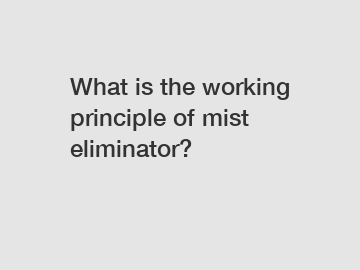What is the working principle of mist eliminator?
Mar. 26, 2024
Mist eliminators, also known as demisters or entrainment separators, are devices used in various industries to remove liquid droplets from gas streams. These droplets, commonly referred to as mists or aerosols, can be harmful if not removed, causing equipment damage, environmental pollution, or health hazards. The working principle of a mist eliminator is based on the principle of inertia and diffusion, allowing for efficient separation of liquid droplets from gas streams.
**Inertia Principle**.
The inertia principle relies on the fact that heavier particles have a higher inertia than lighter particles. When a gas stream carrying liquid droplets passes through a mist eliminator, the droplets tend to move in a straight line due to their momentum. The mist eliminator is designed with obstacles or barriers that cause a change in direction in the gas stream, while the liquid droplets continue along their original path due to their inertia. As a result, the liquid droplets collide with the barriers and are separated from the gas stream.

**Diffusion Principle**.
The diffusion principle involves the movement of liquid droplets from an area of high concentration to an area of low concentration. In a mist eliminator, the gas stream carrying liquid droplets passes through a medium with a large surface area, such as a mesh or coalescing plate. The liquid droplets diffuse through the medium, spreading out and coalescing into larger droplets. These larger droplets are then collected and drained out of the mist eliminator, leaving the gas stream free of liquid particles.
**Types of Mist Eliminators**.
There are several types of mist eliminators available, each designed to suit specific operational requirements and conditions:
- **Wire Mesh Demister:** Utilizes a knitted wire mesh to capture liquid droplets through the inertia principle.
- **Vane Type Mist Eliminator:** Employs vanes or blades to change the direction of the gas stream and separate liquid droplets.
- **Fiber Bed Mist Eliminator:** Consists of layers of fibers or coalescing materials that trap liquid droplets through diffusion.
- **Baffle Plate Demister:** Uses a series of plates or baffles to create turbulence and separate liquid droplets from the gas stream.
**Applications of Mist Eliminators**.
Mist eliminators are commonly used in various industries, including petrochemical, power generation, pharmaceutical, and wastewater treatment plants. They play a crucial role in maintaining the efficiency and safety of equipment by removing harmful liquid droplets from gas streams. In petrochemical plants, mist eliminators are used to protect compressors, scrubbers, and heat exchangers from corrosion and fouling. In power plants, mist eliminators help to reduce emissions and improve the efficiency of air pollution control systems.
In conclusion, the working principle of a mist eliminator is based on the principles of inertia and diffusion, allowing for the efficient separation of liquid droplets from gas streams. By utilizing this technology, industries can ensure the safety and efficiency of their equipment while minimizing environmental impact. With various types of mist eliminators available for different applications, it is essential to select the right one based on operational requirements.
If you have any further questions about mist eliminators or would like to discuss your specific needs, please do not hesitate to contact us.
For more information, please visit mist eliminator pad for sale, spray pump filters for sale, airless spray gun filters.
22
0
0

Comments
All Comments (0)